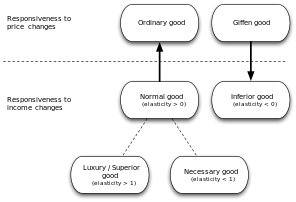Good (economics)
In economics, a good is a material that satisfies human wants[1] and provides utility, for example, to a consumer making a purchase while getting an enough-satisfying Product.A common distinction is made between 'goods' that are tangible property and services, which are non-physical.[2]
Commodities may be used as a synonym for economic goods but often refer to marketable raw materials and primary products.[3]
A consumable item that is useful to people but scarce in relation to its demand, so that human effort is required to obtain it. In contrast, free goods, such as air, are naturally in abundant supply and need no conscious effort to obtain them.
Although in economic theory all goods are considered tangible, in reality certain classes of goods, such as information, only take intangible forms. For example, among other goods an apple is a tangible object, while news belongs to an intangible class of goods and can be perceived only by means of an instrument such as print, broadcast or computer.
Contents
Utility characteristics of goods
Goods may increase or decrease their utility directly or indirectly and may be described as having marginal utility. Some things are useful, but not scarce enough to have monetary value, such as the Earth's atmosphere, these are referred to as 'free goods'.In economics, a bad is the opposite of a good. Ultimately, whether an object is a good or a bad depends on each individual consumer and therefore, it is important to realize that not all goods are good all the time and not all goods are goods to all people.
Types of goods
Types of goods in economics.
Price elasticity also differentiates types of goods. An elastic good is one for which there is a relatively large change in quantity due to a relatively small change in price, and therefore is likely to be part of a family of substitute goods; for example, as pen prices rise, consumers might buy more pencils instead. An inelastic good is one for which there are few or no substitutes, such as tickets to major sporting events[citation needed], original works by famous artists[citation needed], and prescription medicine such as insulin. Complementary goods are generally more inelastic than goods in a family of substitutes. For example, if a rise in the price of beef results in a decrease in the quantity of beef demanded, it is likely that the quantity of hamburger buns demanded will also drop, despite no change in buns' prices.
This is because hamburger buns and beef (in Western culture) are complementary goods. It is important to note that goods considered complements or substitutes are relative associations and should not be understood in a vacuum. The degree to which a good is a substitute or a complement depends on its relationship to other goods, rather than an intrinsic characteristic, and can be measured as cross elasticity of demand by employing statistical techniques such as covariance and correlation.
The following chart illustrates the classification of goods according to their exclusivity and competitiveness.
Main article: Rivalry (economics)
| Excludable | Non-excludable | |
| Rivalrous | Private goods food, clothing, cars, parking spaces |
Common-pool resources fish stocks, timber, coal |
| Non-rivalrous | Club goods cinemas, private parks, satellite television |
Public goods free-to-air television, air, national defense |
Trading of goods
Main article: Trade
Goods are capable of being physically delivered to a consumer. Goods that are economic intangibles can only be stored, delivered, and consumed by means of media.Goods, both tangibles and intangibles, may involve the transfer of product ownership to the consumer. Services do not normally involve transfer of ownership of the service itself, but may involve transfer of ownership of goods developed by a service provider in the course of the service. For example, distributing electricity among consumers is a service provided by an electric utility company. This service can only be experienced through the consumption of electrical energy, which is available in a variety of voltages and, in this case, is the economic goods produced by the electric utility company . While the service (namely, distribution of electrical energy) is a process that remains in its entirety in the ownership of the electric service provider, the goods (namely, electric energy) is the object of ownership transfer. The consumer becomes electric energy owner by purchase and may use it for any lawful purposes just like any other goods.











Post A Comment:
0 comments: